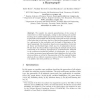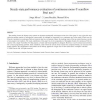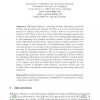427 search results - page 49 / 86 » A Subexponential Bound for Linear Programming |
ICALP
2000
Springer
13 years 11 months ago
2000
Springer
We consider two natural generalizations of the notion of transversal to a finite hypergraph, arising in data-mining and machine learning, the so called multiple and partial transve...
JGO
2010
13 years 2 months ago
2010
The best known method to find exact or at least -approximate solutions to polynomial programming problems is the spatial Branch-and-Bound algorithm, which rests on computing lower...
JSAT
2006
13 years 7 months ago
2006
Cutting planes are a well-known, widely used, and very effective technique for Integer Linear Programming (ILP). However, cutting plane techniques are seldom used in PseudoBoolean...
AUTOMATICA
2005
13 years 7 months ago
2005
The number of states in discrete event systems can increase exponentially with respect to the size of the system. A way to face this state explosion problem consists of relaxing t...
PSD
2010
Springer
13 years 6 months ago
2010
Springer
Minimum-distance controlled tabular adjustment methods (CTA), and its restricted variants (RCTA), is a recent perturbative approach for tabular data protection. Given a table to be...



